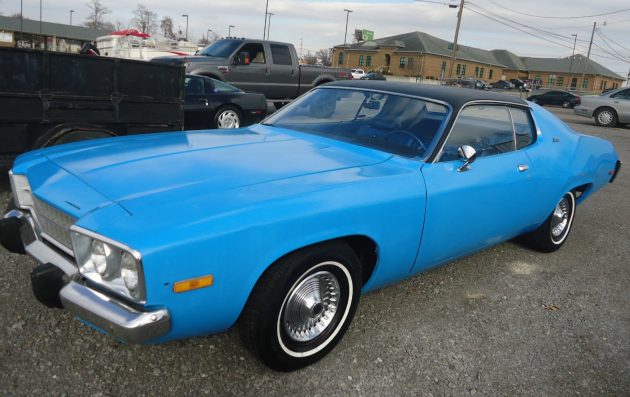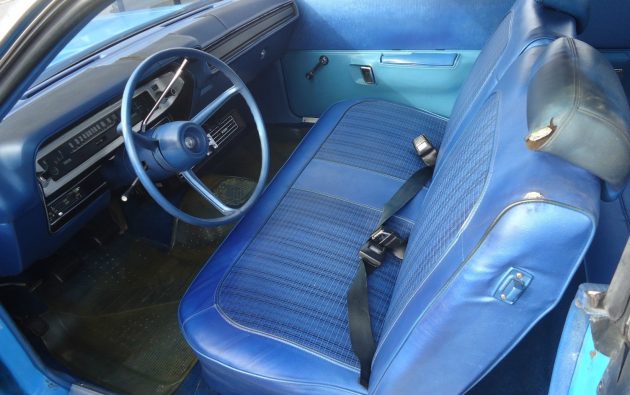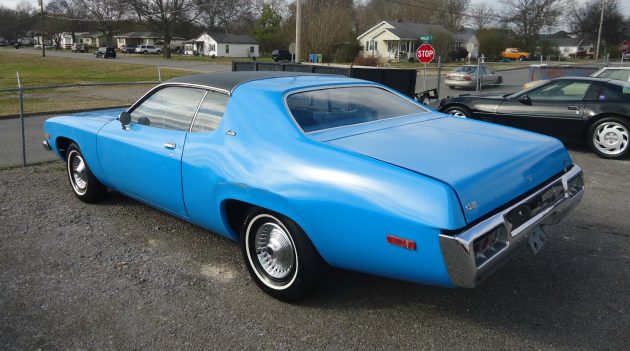Grandma sure was groovy. That’s the only way I can envision the former owner of this survivor-grade Plymouth Satellite here on eBay, which wears just over 15,000 original miles and is clad in Petty Blue paint from head to toe. With a three-on-the-tree and a grandma-friendly six cylinder up front, this Satellite won’t win any drag races but it may just take home a few prizes at your local car show. Bidding is just under $2,000 with the reserve unmet and four days left on the auction.
Check out that interior! Hope you like blue everything. I actually dig blue interiors, and it’s a big reason why I bought my 1987 BMW 535is a few years ago. I attribute it to an old Mercedes 300E my Dad drove that was smoke silver paint over a deep navy interior and to this day is one of my favorite cars of his. This one looks to be in exceptional condition, with unripped seating surfaces and protected carpets. The headrests are bit more faded than I expected, but I’m guessing proximity to an open window is the culprit.
The car retains almost all of its original features, down to the dangerously rotted tires and the factory under-dash A/C (at least I assume it’s factory – maybe our Mopar fanatics can confirm if this year Satellite could be ordered with it). The seller notes there are some dings and dents to be expected of an elderly driver but that the car is overall rust-free. In this photo, the engine bay looks clean and the chrome retains a like-new finish. Same goes for the hubcaps, that are all present and accounted for.
Look at that paint! If I didn’t know this color’s connection to the legendary Richard Petty, I’d say this grandma-owner ran over a tribe full of Smurfs. The vinyl top doesn’t appear to be hiding any rust, as that’s the one place I’d consider suspect on even the cleanest of vehicles. Now, a few minutes of digging reveals there’s sometimes confusion between Grabber Blue and Petty Blue – and whether these were special-order paint colors. I simply think it looks great, but if our readers can confirm how to tell one from the other (aside from looking at a trim tag), I’m sure we’d appreciate the clarification!






Ford called a similar color Grabber Blue. Chrysler never used the word Grabber as a paint name. I doubt this color was named Petty Blue in 73, but it’s likely that it shares the code with it.
Oh, and Grabber Blue is a little more ‘purpley’ or than the color often called ‘Petty Blue’, which is more like ‘Electric Blue’.
You can’t go by colours as they appear over the internet.
this is an outstanding example of a time machine—-leave this exactly the way you see it however replace the tires with modern new sage ones in the same trim—i love mopars–im only wishing this was within my means right now as a classic example of something rare and almost pristine—-clear out the warehouse or garage ,get the cover out this one will find a new home damm soon-wish it was my home though-
the right rear is stuffed and the trunk shut line suggests a hard hit …it’s an oddball with the 225 and three on the tree. could be a nice conversation starter at your local show … 3 grand ? i dunno if i would even go that high …the reserve is probably 5k , just a guess…
No power steering or power brakes and add on air. I wonder how many kids could drive this one. LOL My auto tech instructor had a yellow one with a 318 auto air car. I actually liked it.
The original Petty Blue, was a color the Petty’s came up with after mixing together two different colors of paint they had leftover from previous jobs, and liked it so good, that they just kept using it……don’t know if they actually patented the color as Petty Blue…..
I think it was more of a trademark thing than a patent, which is why I doubt Chrysler called it ‘Petty Blue’, even though, knowing that this color/paint code was used from 1972-1977 by Plymouth under various names, is as close as you can get to their trademark color.
Thanks The Walrus!…..trademark, I think was the word I was looking for, instead of patent….it as about as close as you can get to Petty Blue
A late friend had one in this same colour, attended his funeral the day after major surgery I don’t think I made a good impression on his family, seeing it makes me a bit teary
Yep, that right quarter panel is sure whacked. Not a small job to get it done right. The decklid adn rear bumper gaps would require further inspection, although the top of the rear body panel looks ok. At first, I was taken with a clean look of the car but then all the imperfections started to pop out. I don’t see much value here given the condition, but haven’t seen many with this power train combo.
I’d keep the slant 6 and rework it for more power. I think 318 would make it a dime a dozen car but a killer in-line 6 would set it apart from the crowd, especially with a manual trans
with 3 on the tree and a slant 6 this looks like a great daily driver to me dents and all. i would make it safe and have fun. i hope the reserve is not to high. great find
Why was the Plymouth Superbird built at all? One reason stands out among all others as dominant: To secure Richard Petty as a NASCAR driver for Plymouth. When Petty caught wind of the Daytona Charger being built for Dodge, he asked if Plymouth was going to construct a similar vehicle. The answer was no. Winning is really all that matters in racing. Petty knew this and knew his brick shaped 1969 Plymouths would not be competitive. So, he agreed to drive for, Ford for the 1969 race season. This was perceived as a significant loss by Plymouth. Significant enough so that, after several go/no go decisions, Plymouth decided to construct the Plymouth Road Runner Superbird to compete with the Dodge Daytona and Ford/Mercury cars. The Superbird satisfied Petty and he returned to drive for Plymouth for the 1970 NASCAR Season. At least that is the story that the public has been told. Other sources have speculated that the whole move to Ford was a power play by Maurice Petty to secure exclusive rights to the distribution of Chrysler race equipment for Petty Enterprises.
Chrysler documents dated 10-7-69 and 11-27-69 state that only six exterior paint colors were available for Superbirds. These were: EB5-Blue Fire Metallic, EW1-Alpine White, EK2-Vitamin “C” Orange, FY1-Lemon Twist, FJ5-Lime Light and EV2-Tor-Red. On the 10-7-69 document there is a cryptic reference to “other colors available inquiry #4923”. No documentation has come forward to indicate that anyone ever utilized this 4923 ordering process.
When one looks at the factory Superbird dealer brochure, however, at the end of the list of available colors is “Corporation Blue”. Someone, somewhere decided that at least a few of the cars built to bring Richard Petty back to Plymouth should be similar in color to his Plymouth race cars. Petty’s cars had been a unique, flat, medium blue for a number of years and the color had become a recognizable symbol of the Petty racing enterprise.
This color is VERY close to the color known as “Corporate Blue” which Chrysler Corp. used on their signage. 12785 is the Ditzler code for the Blue “Corporate Identity” color. It is doubtful that Richard Petty chose his shade of blue to match the Chrysler Corporate Blue. When asked about the color of his cars, he related a story about how when it came time to paint one of their cars, they did not have enough dark blue to do the entire car. They looked on the shelf and found a can of white, that when combined with the blue, would be enough to paint the entire car. So they mixed them together and painted the car. Later, it was decided that the color was appealing, so they continued to paint their cars this color.
The code “999” was used by Chrysler to denote a special paint color not normally available among the paint choices for a given year. So, if you were a fleet buyer and wanted a bunch of cars painted your company shade of whatever, you specified the color and Chrysler just inserted 999 where a code such as FJ5 or EV2 would have been on the fender tag and build sheet.
Since Corporate Blue was not a normal color applied to Plymouths in 1970, the cars that received Corporate Blue were coded 999. Understandably, the intention behind painting these cars and the closeness of the color to Petty’s race cars eventually led to people calling these cars Petty Blue cars despite the fact that they were actually Corporate Blue.
Also unique to Petty/Corporate Blue cars is the “C37D” code in the third line and the range of “J Numbers” found at the end of the 5th row.
The best explanation for “C37D” that I have heard is that it is a Sales Code for the Corporate Blue color. C37D appears on the fender tag in a location that is normally blank on Superbirds. It does not replace a typical code in the same way 999 would replace EV2. It is possible that, because 999 does not clarify which unusual color is to be applied, that a second code was necessary to show that Corporation Blue was the particular unusual color to be applied in this case. Please click the link below to see a copy of an internal Chrysler document discussing the process for ordering Corporate Blue on Superbirds.
I got most of this information from the old internet by just putting in Google search Petty Blue.
sounds like the low winded tripe that Mark guy spews on the rusty Mopar show on tv
I believe it was also called “basin Street blue” or at least that’s what Martin Senour paint code was?
It had several names depending on the model/year. Basin Street was indeed one of them.
Exactly, I had a 73 Road Runner that was “basin Street blue” with a white stripe and blue interior, in 73 that was the name, thanks……
What an interesting oddball! Of course, I’m partial to the color combo and top, as this is nearly a knockoff of my ’70 Mustang!
This is definitely not the original paint. Under the hood there is overspray all over the place, including the painted hood springs and brackets, in the trunk it looks like they just sprayed everything, even the trunk hinges are blue. If this really only has 15k miles on it, it sure has been at a few demolition derbys already.
Ummm… Chrysler hinges are always painted. I don’t see any non-factory overspray under the hood, either.
Put it this way… my dad ordered a new 1971 Satellite from his father (a CP dealer). It came, from the factory, with a repainted front fender, wherein they had masked around the parking lights and painted over the original 383 sticker and placed another over it. These were ‘hand fixed’ at the factory to a very low standard. Looks totally legit as original. Body shops are rarely that sloppy.
The left side hood bracket clearly shows overspray compared to the right side. The rubber strip under the hood towards the front has blue overspray all over it. I also looked at other underhood shots of Plymouth satellites, they are black, not the body color.
Hasn’t been painted – they’re like that – trunk, hinges etc – no radio – love it – I’d drive it before I criticised it – hate 3 speeds – why not a 904? – weird one – well done boys
Ah, it’s missing the underhood insulation, that’s what is making it look off.
Underhood insulation? On a Plymouth? What planet are you from? Have you ever really looked at an unrestored Plymouth? Good gravy man! You need some education on these!
Why do I need an education? Under Hood Insulation. Internet search shows plenty of results.
From what I see in the pictures it looks like there has been some paint work done. That is very common for older cars.
Usually the posts I see on here talk about cars.
Sure it did. It’s been common for 30 years. But we are talking about a 40+ year old car, so you need to educate yourself. As I and others have explained, overspray on a car of this vintage IS NOT indicative of work done. In fact, it is a badge of originality, like a scar in fine leather.
You need an education, because I am here to educate others on what originality means. Inaccurate expectations, such as those opinions you have posted, diminish the hobby in general. You are clearly not even somewhat aware what these cars were like when new, let alone an expert (which I would never consider myself as, but I know a ton about originality of 1955-1982 Chrysler products and would challenge anyone to a duel over it).
You, sir, are disseminating opinions as knowledge based on the way things are in 2016. Most cars do have underhood insulation (as you stated in your original reply, since deleted). But that is 2016 thinking, not 1973 thinking. Plymouth was Chrylser’s bargain brand. Underhood insulation may have been an option, but it would never have been installed on a base model slant 6 with 3 on the tree. I’m saying educate yourself, because your observations on this car are way way way off the mark for how they came from the factory. This car, in my opinion, looks 100% exactly from what one would expect for an unrestored car. overspray was unpredictable, particularly in Chrysler products. When I said body shops would never do it this way, I meant it. Only the factory would do with the paint what I see in this one. Nobody would think to do it, because the factory didn’t think about what they were doing.
I do not know why you keep telling me I need an education!
I have an opinion based on what I see in some pictures, that’s all.
.
On early 70’s Plymouths? You do. Because there is fact available, and I wish for people to be educated. Opinion is irrelevant. But if you feel that you don’t need fact, I guess you’ll never be capable of understanding.
So a ride in your grandfathers car can make you give facts about this particular car for sale? Is this your car for sale? How do you know the facts about this car so intimately? Please educate me about how you know so much about this particular car listed here on Barn Finds. I don’t appreciate that you keep telling me how I need to be educated, when you have no facts about my education!
No, the fact that I have traded hundreds of these since I was born makes me an amateur on the understanding of what these are supposed to look like. I do not know this particular car at all, but my experience (which is often paid for, and considered by some expert advice) tells me it is what is expected. I have no idea of your experience, but it is clear to me (and every other MOPAR guy on here) that you have potential, but you don’t know what you are looking at, and therefore require education.
Yup, no hood insulation on my 73 Road Runner, it was an 83,000 mile car that wasn’t tampered with, it also had over spray everywhere…….
It does look like it had some paint work on rear of car wire’s look to be painted blue.
A rubber molding piece between bumper and body is missing big gap there would want a closer look, slant 6- 3 in the tree not my cup of tea.
All I’m saying is, having been brought home from the hospital in a ’71 my grandfather received directly from Chrysler, and my dad accepted, that had poorly masked overspray on the passengers front parking light, an overpainted decal which had a new decal placed on top of it, and overspray on the passenger front wheel cover (in addition to a radiator full of casting sand from the 383), I would say that the things people are observing on this car are factory original. It was a sad time for Chrysler’s low line car, to be sure.
Still, 15k mileage? 35yrs ago, maybe…!
ROFLMAO
Argue about paint all you want, this is not “unmolested”!
I’ll go to bed now.